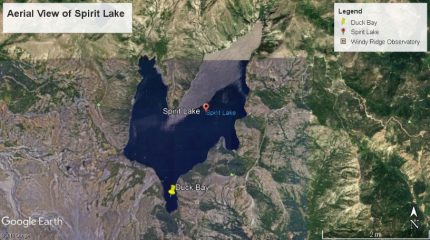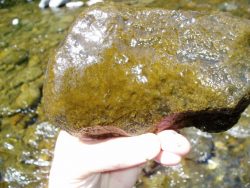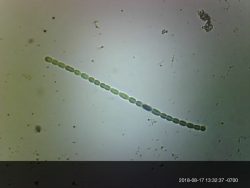by Angelica Lucchetto and Avery Shinneman, University of Washington Bothell, School of Interdisciplinary Arts and Sciences
“Biofilm” is a loose term describing a complex assemblage of bacteria and other microorganisms that secrete a mucilaginous coating [often extracellular polymeric substances (EPS)] which causes them to stick to each other and to surfaces. Essentially, biofilm is the slimy stuff that makes you slip when you step on a wet rock or log. However, biofilm is so much more than just a nuisance to lake-goers. It is actually a diverse and dynamic environment, and an essential part of the food web in many lakes. Biofilms provide a unique habitat niche for many organisms that may not be found anywhere else in a lake ecosystem.
In the summer of 2018, a group of researchers from the University of Washington travelled to Spirit Lake, nestled in the shadow of Mount St. Helens. Thanks in part to the WALPA undergraduate student scholarship, I was able to join this research team. The eruption of Mount St. Helens in 1980 felled the surrounding trees, many of which fell into Spirit Lake. Today, these trees form a log mat that covers 20% of the lake’s surface. The underside of this log mat is covered in a layer of biofilm, which may amount to more than 2.5 km2 of biofilm at the lake surface (Sevier et al. 2018). Our initial study found that, in the late summer, one of the most abundant groups present on the log mat was cyanobacteria. In contrast, these cyanobacteria were very sparse in plankton tows from several locations around the lake, showing that the log mat biofilm provides an ideal environment for their growth. Bartrons et al. found that cyanobacteria have unique characteristics such as an involvement in oxygenic photosynthesis and nitrogen fixation, which allows them to colonize environments such as the log mat, where nutrient availability might otherwise be too low for significant growth.

Biofilms are also metabolically and biologically diverse. Bartrons et al. collected data from oligotrophic mountain lakes similar to Spirit Lake. Their data suggest the presence of aerobic, anaerobic, phototrophic, and chemotropic microorganisms all coexisting in benthic microbial biofilms attached to rocks. Another study by Sorokovikova et al. demonstrates how species compositions of cyanobacteria varied depending on the physical and chemical properties of different substrates. Epilithic cyanobacteria appear to be highly adaptable to different environments. Supporting this notion, Ma et al. found that the structural and functional attributes of biofilms differed depending on the land use and water quality of the surrounding areas. If the composition and function of biofilms is different in every environment, it must mean that a great variety of organisms can live in them. Our study found this to be true. At the height of the growing season (mid-July), 41 different species could be identified in the log mat biofilm. In contrast, our plankton tows contained an average of fewer than four different species over the entire sampling period, suggesting that biofilm is a much more diverse part of the lake ecosystem in terms of cyanobacterial growth.
Because they are so diverse, biofilms are a major component in aquatic ecosystems and food webs. The species richness shown in our data suggest many possible food sources for invertebrates and insects, building the basis of a complex food web based around the log mats. Sorokovikova et al. found that mucilage from cyanobacteria serves as a nutrient substrate for heterotrophic bacteria. In addition to being a food source, cyanobacteria in biofilms also contribute to nitrogen cycling in lake systems. In their study of oligotrophic high-altitude lakes, Vila-Costa et al. discovered a close coupling between nitrification and denitrification in biofilms. Our own study hypothesized that contributions from biofilm cyanobacteria could explain the disconnect between a greater modelled outflow than inflow of nitrogen from Spirit Lake. Our current data do not support this claim, but further research is needed to calculate accurate fixation rates for the lake.
In fact, further research is needed on biofilms in general. Several of the aforementioned studies have noted that biofilms are often considered to be “irrelevant,” “difficult to handle experimentally,” and “poorly explored.” Sorokovikova et al. noted that there is not much information about the genetics and species diversity of biofilm communities. If more people studied biofilm, we could gain new knowledge and perspectives on aquatic food webs, planktonic metabolisms, and how lake systems differ based on their environments. Through our study of log mat biofilms in Spirit Lake, we hope to contribute further insight into the functionality and diversity of biofilms.
References cited:
Sevier E., Fox-Dobbs K., Gawel J., Davis J., Shinneman A. (2018) The role of logmat biofilm in energy and nutrient cycles at Spirit Lake. Washington Lakes Association Annual Meeting. Portland, OR.
Bartrons M., Catalan J., Casamayor E. O. (2012) High Bacterial Diversity in Epilithic Biofilms of Oligotrophic Mountain Lakes. Microb Ecol. 64:860–869
Sorokovikova E. G., Belykh O. I., Gladkikh A. S., Kotsar O. V., Tikhonova I. V., Timoshkin O. A., Parfenova V. V. (2013) Diversity of Cyanobacterial Species and Phylotypes in Biofilms from the Littoral Zone of Lake Baikal. Journal of Microbiology. 51:6:757–765
Ma M., Liu J., Wang X. (2011) Biofilms as potential indicators of macrophyte-dominated lake health. Ecotoxicology. 20:982–992
Vila-Costa M., Bartrons M., Catalan J., Casamayor E. O. (2014) Nitrogen-Cycling Genes in Epilithic Biofilms of Oligotrophic High-Altitude Lakes (Central Pyrenees, Spain). Microb Ecol. 68:60–69











